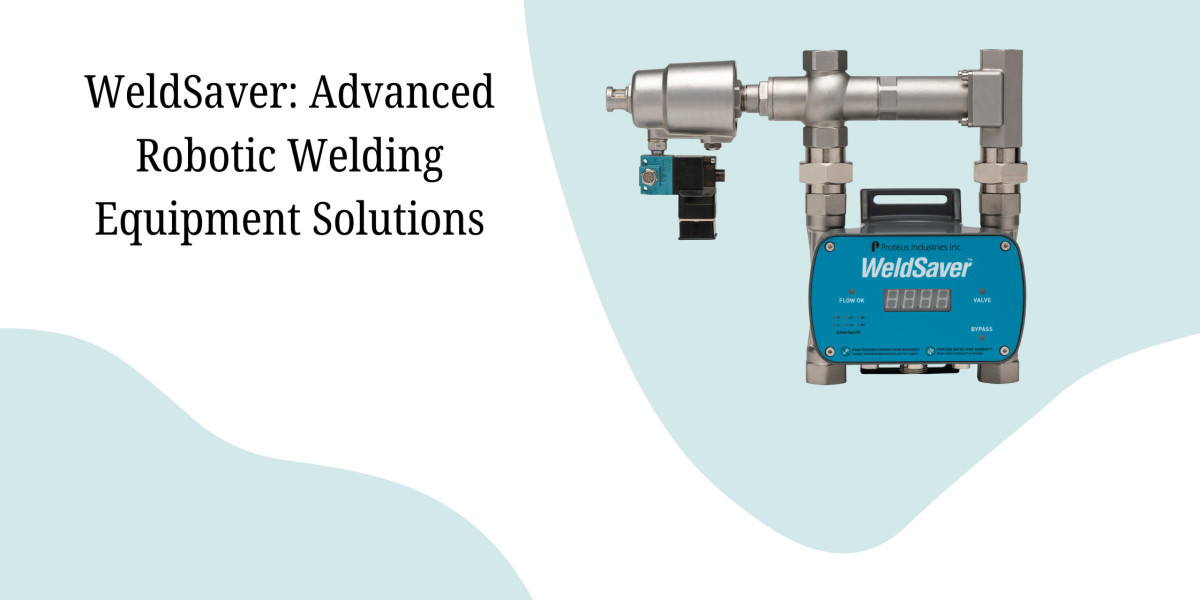In todays fast-paced manufacturing industry, efficiency, precision, and equipment safety are non-negotiable. As robotic welding systems become more advanced and widely used, maintaining the integrity of these high-performance machines is crucial. Thats whereWeldSaver comes in, a cutting-edge solution designed to safeguard and optimise your robotic welding equipment.
WeldSaver by Proteus Industries is an innovative monitoring and protection device tailored specifically for robotic welding applications. Its primary role is to detect cooling fluid flow interruptions and coolant leaks in real time, preventing costly damage to robotic welders and workpieces.This smart device offers immediate weld cell shutdown upon detecting anomalies, dramatically reducing downtime, equipment repair costs, and production losses.
The increasing demand for robotic welding equipment in automotive, aerospace, and heavy industries has made solutions like WeldSaver indispensable.By incorporating advanced sensors and intelligent monitoring capabilities, WeldSaver ensures your robotic welders operate at peak performance while protecting valuable machinery from potential hazards.
For manufacturers seeking reliable, real-time protection for their robotic welding investments, WeldSaver provides unmatched security, precision, and peace of mind.Explore how this technology works and what its benefits are at Proteus Industries WeldSaver Overview.
Understanding Robotic Welding Equipment
Robotic welding equipment is designed to automate the welding process using robotic arms programmed to perform high-precision and speed welding tasks. These systems are used in various welding applications, including arc, spot, and laser welding. Robotic welding systems can handle tasks traditionally requiring skilled human welders, such as intricate and repetitive welds, with greater efficiency and consistency.
Robotic welding equipment's core is the robots, which are typically equipped with specialised welding tools or plasma cutters. These robots are programmed using advanced software that allows them to follow detailed welding paths and adapt to changes in the workpiece geometry.
Robotic welding equipment is widespread in industries requiring high-volume production, such as automotive manufacturing, aerospace, and heavy equipment production. Automating welding processes helps businesses keep up with the demands for higher-quality products and faster turnaround times.
How Robotic Welding Works?
The essential operation of robotic welding equipment relies on several integrated components working together seamlessly. The robotic arm is at the heart of the system, designed with multiple joints that allow it to rotate, extend, and move with precision. This arm is programmed to perform exact welding movements tailored to each task. Complementing this is the welding power source, which provides the necessary energy for the welding process, varying based on the technique used. The entire system is managed by a controller and specialised software, which stores the programming and controls the robotic arms movements, enabling adjustments to the welding path and fine-tuning of process parameters. To maintain accuracy, sensors and vision systems are incorporated, allowing the robot to detect changes in the workpiece and make real-time adjustments. The welding process typically begins with the workpiece placed securely on a fixture or conveyor. The robot, guided by its programmed instructions, moves the arm into position, activates the welding tool, and follows the predetermined path. Throughout the operation, the robot continuously monitors weld quality through its sensors, making adjustments to ensure consistent, high-quality results with every cycle.
Benefits of Robotic Welding Equipment
The benefits of robotic welding equipment are vast and far-reaching. Here are some of the key advantages:
- Increased Precision and Consistency: Robotic welding equipment guarantees that each weld is performed with the same level of accuracy and consistency. Unlike human welders, robots dont experience fatigue or variability, which can result in errors. This leads to higher-quality products and reduced rework or scrap.
- Enhanced Safety: Welding is a dangerous job that involves exposure to heat, sparks, and toxic fumes. Workers can avoid hazardous environments by automating the process with robotic welding equipment, reducing the risk of injuries and fitness concerns.
- Higher Productivity: Robotic systems can work around the clock without breaking or shifting changes. This dramatically increases the overall productivity of welding operations, especially in industries that require mass production of components.
- Reduced Labour Costs: While robotic systems require an initial investment, they can significantly reduce labour costs over time. Fewer human welders are needed, and the robots can perform welding tasks that would otherwise require a large workforce, leading to savings in labour expenses.
- Flexibility and Adaptability: Robotic welding systems can be reprogrammed for different tasks. This makes them ideal for industries that produce a variety of components, as the robots can be easily adapted to other welding techniques and workpieces.
When Should You Consider Robotic Welding Equipment?
Deciding when to integrate robotic welding equipment into your operations depends on several factors, including production volume, complexity of the welding task, and budget. Here are some scenarios where robotic welding equipment could be a worthwhile investment:
- High-Volume Production: If your business operates in an industry that requires high-volume production, such as automotive manufacturing, robotics can significantly improve throughput and reduce cycle time.
- Complex Welding Jobs: For welding tasks that require high precision or involve complex geometries, robotic welding can ensure that every weld meets the required specifications.
- Repetitive Welding Tasks: If your welding tasks involve repetitive actions, robotic systems can take over, freeing up skilled welders for more complex or high-level work.
- When Labour Costs Are a Concern: If your business is looking to reduce labour expenses in welding operations, robotic welding equipment can help automate tasks that traditionally require a large workforce.
Explore the Latest Robotic Welding Equipment Innovations
The future of welding is being shaped by advancements in robotics, particularly the development of more intelligent, efficient, and versatile robotic systems. Some of the most notable innovations include:
- Collaborative Robots (Cobots): These robots work alongside human operators, assisting them in tasks without requiring safety cages. Cobots are ideal for small to medium-sized enterprises looking to improve their welding processes without investing in large-scale automation systems.
- Additive Manufacturing in Welding: Additive manufacturing techniques like 3D printing are integrated into robotic welding systems. This variety allows for the invention of complex metal parts layer by layer, reducing waste and enabling custom designs that would be difficult to achieve with traditional welding methods.
- Smart Sensors and Vision Systems: Advanced sensors and vision systems allow robots to detect and respond to changes in the workpiece automatically. These systems ensure the robot can adjust its movements for any size, shape, or position variations, guaranteeing precise and high-quality welds.
One example of cutting-edge robotic welding technology is Proteus Industries' WeldSaver, which offers automatic coolant control and system protection to help optimise the welding process and prevent costly downtime. This innovative system integrates seamlessly with robotic welding setups, providing more accurate cooling during the welding process, reducing the risk of overheating, and improving overall system longevity.
Why Robotic Welding Equipment is the Future?
Robotic welding equipment is the industry's future because it combines several advantages, including enhanced safety, cost savings, and increased productivity. As technology advances, robotic systems will become even more efficient, cost-effective, and adaptable to various industries and applications.
Automation trends are only increasing, and robotic welding is a key component in this shift. Robotic welding systems will meet these needs as industries demand higher quality, faster production times, and lower costs. With the dawn of intelligence, machine learning, and advanced vision systems, the potential for robotic welding equipment is limitless, offering unprecedented performance and capability.
Conclusion
The future of welding is bright, and robotic welding equipment is at the forefront of this revolution. From increasing productivity and precision to improving safety and reducing labour costs, innovations in robotic welding are changing the landscape of industrial manufacturing. As businesses continue to embrace automation, robotic welding processes will significantly drive efficiency, innovation, and profitability across various industries. By staying ahead of these technical advancements, companies can remain competitive and prepared for future challenges.
FAQs
What are the major benefits of using automated welding equipment?
Robotic welding equipment offers increased precision, higher productivity, enhanced safety, reduced labour costs, and better weld quality.
How does robotic welding improve workplace safety?
Robotic welding reduces the need for human operators to be exposed to dangerous conditions, such as intense heat, toxic fumes, and sparks, improving overall safety.
Can robotic welding equipment handle complex welding tasks?
Yes, robotic welding equipment can handle complex welding tasks with high precision, making it ideal for industries like aerospace and automotive.
How do I know if robotic welding equipment is right for my business?
If your business requires high-volume production, complex welding tasks, or reduced labour costs, robotic welding equipment may be a good investment.








